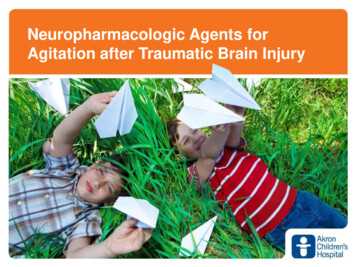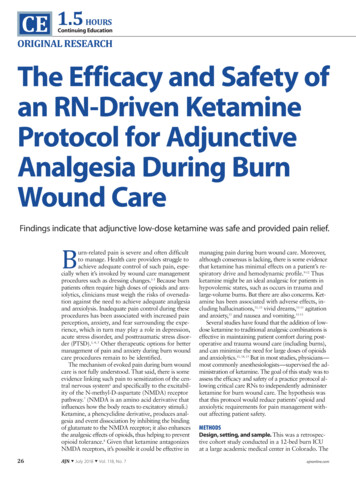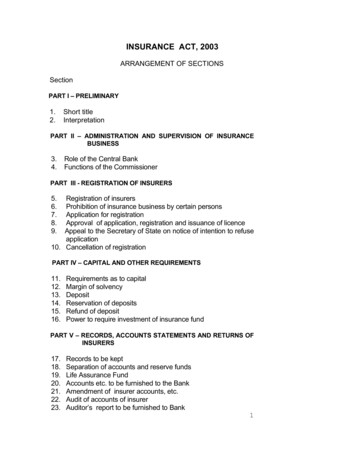
Transcription
Neuropharmacologic Agents forAgitation after Traumatic Brain Injury
Disclosures Most, it not all, of themedications discussedhave not been tested inpediatric populations. Most, if not all, themedications discussedare being used off-labelin pediatric populations. No financial disclosures
Agitation after TBI: Impact Adults 3x more likely in first 6 months after headinjury to show aggression than those withmultiple traumatic injuries without head injury 25% of adults showed aggressive behavior 60months after discharge from inpatientrehabilitation unit for TBI 70% of adults during inpatient TBI rehabilitationexperience agitation Agitation has been shown to negatively affectrate of recovery in acute inpatient rehabilitation
Agitation after TBI Symptoms:–––––––Physical and verbal aggressionExplosive angerAkathisiaIrritabilityMood labilityMaladaptive behaviorDisorientation
Management of Post-TBI Agitation Identify and address possible cause/contributorsincluding:– Sleep disruption / alteration of sleep wake cycle– Sources for discomfort Lines/cathetersUnidentified injury (fracture, etc)Inadequate pain controlGastrointestinal distress (reflux, constipation, ileus)– Seizures subclinical epilepsy can present as intermittent aggression–––––Disorientation, post-traumatic amnesiaNeuroendocrine dysfunctionPost-traumatic hydrocephalusDrug withdrawal (pain medications, other meds from ICU)Polypharmacy
Pharmacologic Management: MeasureIntervention Response Identify symptom that causes ionAkathisiaDisorientationAcquired mood disorder (depression/anxiety)Mood lability Monitor frequency of disruptive behavior/symptomthrough close observation Monitor frequency of activity disruption Use outcome measures . . .
Agitated Behavior Scale (ABS)
Non-Pharmacological Management ofPost-TBI Agitation Environmental Controls– Reduce Noise (turn off TV, monitors if possible)– Reduce interruptions (minimize and cluster vitals/medadministration/nursing care)– Limit number of visitors at a time– Allow for down-time for patient Reduce contributors to agitation– Orientation/Memory strategies– Identify and treat pain– Eliminate unnecessary medications Behavioral management– Coordinated program to address specific behaviors– Incorporate entire care team (family members, psychology,nursing, therapists)
Pediatric Research on Pharmacologicmanagement of Agitation after TBI Extremely Limited 1 prospective study Few case series/reports
Adult Research on Pharmacologicmanagement of Agitation after TBI Cochrane review last updated 2008 6 studies met criteria (RCT’s) for meta-analysis––––Propranolol (2)Pindolol (2)Methylphenidate (1)Amantadine (1) Research supports use of -Blockers Effect seen within 2-6 weeks Response similar in both subacute and chronictimeframe
Benzodiazepines Work on GABA molecule to create:– Anxiolytic, sedative, antispasticity, anticonvulsant andAMNESTIC effects Effect duration varies based on medication– Short (1-8 hour half life) – e.g. midazolam, alprazolam– Intermediate (8-40 hour half life) – e.g. lorazepam– Long ( 40 hours) – e.g. Diazepam, clonazepam
Benzodiazepines
Benzodiazepines: Side Effects Side effects include the following:––––Amnesia/memory lossIncreased daytime fatigueDecreased concentrationDecreased alertness TBI causes the above effects as well Repeated use of benzodiazepines mayslow/impair neuronal recovery after focal injury
Benzodiazepines: Research Pediatric Research:– None
Benzodiazepines: Take Home Points Use of benzodiazepines is discouraged due toside effects confounding and even delayingrecovery after brain injury Limited use on an as needed basis may beappropriate
-Blockers Proposed mechanism of reducinghyperadrenergic activity Commonly used for periodic autonomicinstability and dystonia (Storming) In retrospective studies shown to improvesurvival when used acutely after ABI Current prospective placebo study looking ateffect of adrenergic blockade acutely after braininjury on survival and functional outcomes(clonidine and propranolol)
-Blockers: Side Effects BradycardiaOrthostatic HypotensionFatigueSedation
-Blockers: Research Pediatric Research:– None Adult Research:– 2 randomized placebo-controlled trials (Brooke 1992,Greendyke 1986) show benefit with propranolol foragitation in the weeks after injury (Brooke) and foraggressive behavior months and years after injury(Greendyke).
-Blockers: Take Home Points Research supports use in adults for agitation– Reduces intensity and frequency of agitation, as wellas need for use of restraints– Doses studied in adults are relatively high, noresearch guidance for effective dosing in children No FDA indication for children No research in children Monitor closely for side effects
Clonidine 2-adrenergicreceptor agonist– Decreases sympathetic tone No studies for agitation after TBI in adults or children Current uses:– FDA approval for ADHD in children 6 RCTs in children with ADHD show decreasedimpulsivity/hyperactivity, and decreased inattention– Emergence agitation after anesthesia– Drug and alcohol withdrawal (adults)– Akathisia associated with withdrawal (adults) May be useful as treatment for akathisia inducedagitation or for inattention
Anticonvulsants Various mechanisms based on medication:– Decrease excitatory neurotransmitter activity– Increase inhibitor neurotransmitter activity– Reduce sub-clinical epileptic activity Seizures can be a source foraggression/confusion/disorientation– Provide mood stabilization
Anticonvulsants
Anticonvulsants: Side Effects Varied basedon medication In children withepilepsyadverse effectson cognitiveand motorfunction havebeen reported
Anticonvulsants: Research Pediatric research:– Valproic acid – 1 study included patients age 13-89. Adult Research (all studies without controls)– Valproic Acid Retrospective study of 28 patients with age range 13-89demonstrated reduction of agitation symptoms with valproic acidin 26 (90%) patients Authors concluded it may be appropriate for alert, labile,impulsive, and disinhibited patients (Chatham Showalter et al,2000)– Carbamazepime Prospective open trial in 8 patients (400-800 mg daily) hadimproved Agitated Behavior Scale (Azouvi et al, 1999) 7 patients showed reduction in combativeness within 4 days(Chatham Showalter et al, 1996)
Anticonvulsants: Take Home Points Used frequently in adults to address symptomsof agitation: mood lability, dis-inhibition, andaggression Studies are limited even in adults to support use No evidence for efficacy in pediatrics
Antidepressants
Antidepressants Proposed mechanism for decreasing agitation:– Treatment of depression/anxiety that contribute toagitation/irritability– Mood stabilization
Antidepressants: Side Effects TriCyclic Antidepressants: arrythmia,convulsions, confusion, suicidality SSRI’s: Behavior changes, sleeplessness,AGITATION, social withdrawal, suicidality,neuroleptic malignant syndrome, serotoninsyndrome
Antidepressants: Research No pediatric studies Very few studies looking at use of antidepressantswith primary outcome of reduction of agitation Multiple studies (including one prospective RCT) inadults addressing post-TBI depression notedreduction in symptoms of depression as well asreduction in agitation with treatment A pilot study demonstrated improved mood, andimproved attention and working memory withfluoxetine
Antidepressants: Take Home Points Use cautiously in children due to risk ofsuicidality Avoid polypharmacy (NMS, Serotoninsyndrome) Might be appropriate to address anxiety anddepression after TBI which contribute toagitation MORE RESEARCH NEEDED
Antipsychotics Mechanism of Action– Typical antipsychotics block D2-dopamine receptor– Atypical antipsychotics have less D2 receptor activity Atypicals likely act on other neurotransmitter pathways,including serotonin, dopamine, -adrenergic, muscarinic,and histamine pathways1
Antipsychotics: Side Effects Movement disorders– Akathisia – one of more common movement disordersseen with antipsychotics a subjective sense of restlessness often accompanied byinvoluntary movements of the limbs or trunk Can worsen agitation– Extrapyramidal Symptoms– Tardive Dyskinesia – choreoathetotic or other involuntaryrepetitive movement Weight gainNeuroleptic Malignant Syndrome (NMS)SeizuresProlonged QT
Antipsychotics: Side Effects
Antipsychotics: Side Effects Cognitive impact– Multiple animal studies have demonstrated eitherslowed cognitive improvement or reduced cognitivereturn with use of antipsychotic medications (bothtypical and atypical)– One human study demonstrated negative cognitiveimpact with use of antipsychotics after TBI thatimproved with discontinuation of medication(Stanislav et al, 1997)
Antipsychotics: Research Typical Antipsychotics– Adult studies suggest may be safe if used sparingly– None have FDA approval for use in children 10 (variesdepending on medication)– No studies in children Atypical Antipsychotics– Adult studies demonstrate efficacy for multiple medications inthis class, but caution use due to side effects– Pediatric prospective study with oral ziprasidone, no control(Level of evidence 4) (Scott et al, 2009) 20 consecutive patients (age 9 months to 17 years)treated withziprasidone as sole agent for agitation (in acute setting 3-8 days oftreatment) Showed reduction in agitation symptoms Increase in symptoms of sedation
Antipsychotics: Take Home Points Though atypicals may be safer, likely allantipsychotic medications have detrimentaleffects with long term use (NMS, TardiveDyskinesia, etc) May be appropriate to use atypicalantipsychotics for short-term limited use inagitation after TBI during the acute period whensedation is not a barrier
Summary: Approach to PharmacologicIntervention for Agitation after Pediatric TBI Little evidence to guide us so:– Identify and treat contributors to agitation when possible– Treatment should include non-pharmacologicenvironmental and behavioral management– Monitor response to intervention Identify symptom of concern and monitor frequency Agitated Behavior Scale (may be most appropriate for adultpatients)– Avoid Polypharmacy if something doesn’t work, stop it before adding more (based onadult resuearch, anticipate effect within 2-6 weeks ofmedication initiation)– Monitor closely for side effects
References Azouvi P, Jokic C, Attal N, Denys P, Markabi S, Bussel B. Carbamazepine in agitation and aggressive behaviour following severe closed head injury:results of an open trial. Brain Inj 1999;13:797-804Chatham-Showalter PE, Kimmel DN. Agitated symptom response to divalproex following acute brain injury. J Neuropsychiatry Clin Neurosci2000;12:395-397.Chatham-Showalter PE. Carbamazepine for combativeness in acute traumatic brain injury. J Neuropsychiatry Clin Neurosci 1996;8:96 -99.Chew E, Zafonte RD. Pharmacological management of neurobehavioral disorders following traumatic brain injury—A state-of-the-art review. Journal ofRehabilitation Research and Development. 2009. 46:6 - 851-878.Cotton BA, Snodgrass KB, Fleming SB, et al. Beta-blocker exposure is associated with improved survival after severe traumatic brain injury. J Trauma2007;62:26-33; discussion 33-35.Fleminger S, Greenwood RRJ, Oliver DL. Pharmacological management for agitation and aggression in people with acquired brain injury (Review). TheCochrane Collaboration. Published by John Wiley & Sons, Ltd. 2008.Goldstein LB. Prescribing of potentially harmful drugs to patients admitted to hospital after head injury. J Neurol Neurosurg Psychiatry 1995;58:753-755.Goldstein LB. Basic and clinical studies of pharmacologic effects on recovery from brain injury. J Neural Transplant Plast 19 93;4:175-192.Hoffman AN, Cheng JP, Zafonte RD, Kline AE. Administration of haloperidol and risperidone after neurobehavioral testing hinders the recovery oftraumatic brain injury-induced deficits. Life Sci 2008;83:602-607.Kline AE, Hoffman AN, Cheng JP, Zafonte RD, Massucci JL. Chronic administration of antipsychotics impede behavioral recovery after experimentaltraumatic brain injury. Neurosci Lett 2008;448:263-267.Kline AE, Massucci JL, Zafonte RD, Dixon CE, DeFeo JR, Rogers EH. Differential effects of single versus multiple administrations of haloperidol andrisperidone on functional outcome after experimental brain trauma. Crit Care Med 2007;35:919-924.Lequerica AH, Rapport LJ, Loeher K, Axelrod BN, Vangel SJ Jr, Hanks RA. Agitation in acquired brain injury: impact on acute rehabilitation therapies. JHead Trauma Rehabil 2007;22:177-183Mysiw WJ, Jackson RD, Corrigan JD. Amitriptyline for post-traumatic agitation. Am J Phys Med Rehabil 1988;67:29-33.Nott MT, Chapparo C, Baguley IJ. Agitation following traumatic brain injury: An Australian sample. Brain Inj 2006;20:1175 -1182.Pangilinan, P et al Neuropharmacology in Pediatric Brain Injury: A Review. PM&R. Vol. 2, 1127-1140, December 2010Patel MB, et al Decreasing adrenergic or sympathetic hyperactivity after severe traumatic brain injury using propranolol and clonidine (DASH After TBIStudy): study protocol for a randomized controlled trial. Trials. 2012 Sep 26;13:177. doi: 10.1186/1745-6215-13-177Perna R. Benzodiazepines and antipsychotics: cognitive side effects.J Head Trauma Rehabil 2004;19:516-518.Suskauer SJ, Trovato, MK. Update on Pharmaceutical Intervention for Disorders of Consciousness and Agitation After Traumatic Brain Injury inChildren. PM R 2013;5:142-147Scott LK et al. Agitation and/or aggression after traumatic brain injury in the pediatric population treated with ziprasidone . J Neurosurg Pediatrics 3:000–000, 2009.Stanislav SW. Cognitive effects of antipsychotic agents in persons with traumatic brain injury. Brain Inj 1997;11:335-341. Scott LK, Green R, McCarthyPJ, Conrad SA. Agitation and/or aggression after traumatic brain injury in the pediatric population treated with ziprasidone. Clinical article. J NeurosurgPediatr 2009;3:484-487.Tang et al; Topiramate in Traumatic Brain Injury: Adverse Effects on Cognitive Function.” J Head Trauma Rehabil. 2007 22;6: 409-10.Tran TY, Dunne, IE et al. Beta blockers exposure and traumatic brain injury: a literature review. Neurosurg Focus 25 (4):E8, 2008
Propranolol: Research
Anticonvulsants adverse effects oncognitive function Topiramate– Studies in epilepsy demonstrate: Behavior problems (15%), decreased alertness (15%),drowsiness (5%), disorientation (5%), unsteadiness (5%) Language impairment– Word-finding difficulty– Decreased expressive output– Decreased verbal fluency and working memory
Agitation: Definitions “Disturbed behavior as a result of overactivity” “Episodic dyscontrol” “subjective evidence of one or more of thefollowing behaviors: restlessness, derogatory orthreatening demands, verbal abusiveness,sexually inappropriate comments or actions, orattempts at physical violence of sufficientseverity to disrupt nursing care or therapy.”
Suskauer SJ, Trovato, MK. Update on Pharmaceutical Intervention for Disorders of Consciousness and Agitation After Traumatic Brain Injury in Children. PM R 2013;5:142-147 Scott LK et al. Agitation and/or aggression after traumatic brain injury in the pediatric population treated with ziprasidone. J Neurosurg Pediatrics 3:000- 000, 2009.










